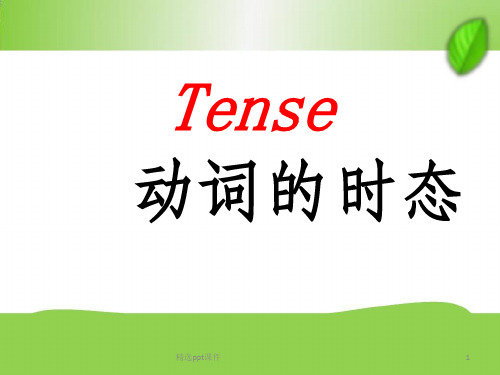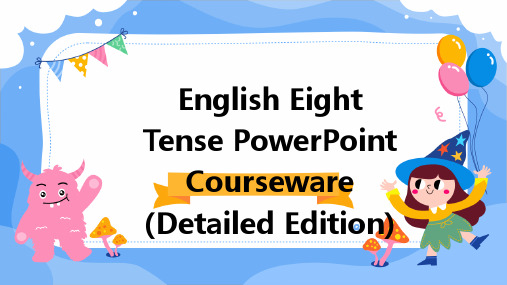初中英语8大时态-课件PPT
合集下载
初中英语八种时态讲解-课件PPT

什么情况下用?
①表示经常或习惯性的动作或存 在的状态。②表示主语通常的能 力、兴趣爱好、和性格特征。③ 表示客观的事实或真理。④表示 按照时刻表或已经计划安排好的 将来行为。(只限于是go, come, leave, arrive, begin, start, take off, stop, be等表示开始或移动意义的 词。)⑤在时间状语从句和条件 状语从句中,主句用一般将来时 (will+动词原形),从句中用一般
变“y”为“i”再加-ed
worry→worried
cry→cried
1. He____(be, was, were, been) here a moment ago. 2. They ____(be, was, were, been) here just now. 3. The scientists _____(leave, leaves, leaved, left) for America yesterday. 4. Last week we ______(visit, visited ) the Science Museum. 5. When I was a child, I often ____(play, played) football. 6. The students ran out of the classroom as soon as the bell ____(ring, rang, rung).
一般过去时
概念:过去某个时间里发生的动作或 状态;过去习惯性、经常性的动作、 行为。 时间状语:ago, yesterday, the day before yesterday, last week(year, night, month…), in 1989, just now, at the age of 5, one day, long long ago, once upon a time, etc. 基本结构:①be动词;②行为动词 否定形式:①was/were+not;②在行为 动词前加didn't,同时还原行为动词。 一般疑问句:①was或were放于句首; ②用助动词do的过去式did 提问,同时 还原行为动词。
英语时态8种基本时态讲解.ppt课件

4)动词过去式变化规则。 a)一般情况下的词加-ed. work---worked call----called b)以不发音的字母e结尾的单词直接加-d . live----lived change----changed smoke----smoked die----died graduate----graduated drive----drove
8.过去完成时 表示动作发生在过去某一时间之前已经完成的动作或状态, 强调“过去的过去”, 常与 by the time, by the end of…,before , by 等引导时间的状语连用。
基本结构 主语+ had + 动词过去分词 + 其他成分 When I got to the cinema yesterday the film had begun already. He had learned English before he came here.
现在完成时与一般过去时的区别: 1)现在完成时侧重于对现在的影响;而一般过去时侧重于某一动作发生在过去某个时间或某段时间。即现在完成时侧重于现在的结果,而一般过去时侧重于动作发生的时间。例如:
I have seen the film. 我看过这部电影。(现在我仍记得电影的内容) I saw the film three days ago. 三天前我看了这部电影。(强调是三天前,而不是别的什么时候看的电影)
be going to含有“打算,准备”的意思,而will则没有这个意思, She is going to lend us her book. He will be here in half an hour.
be about to+V.原形(意为马上做某事,在时间上指最近的将来) I am about to leave school. 不能与表示时间的副词连用。 They are about to set out.(√) They are about to set,变y为i加-ed. study----studied carry----carried cry----cried try----tried d)以元音字母+y结尾的单词直接加-ed. play----played stay----stayed
8.过去完成时 表示动作发生在过去某一时间之前已经完成的动作或状态, 强调“过去的过去”, 常与 by the time, by the end of…,before , by 等引导时间的状语连用。
基本结构 主语+ had + 动词过去分词 + 其他成分 When I got to the cinema yesterday the film had begun already. He had learned English before he came here.
现在完成时与一般过去时的区别: 1)现在完成时侧重于对现在的影响;而一般过去时侧重于某一动作发生在过去某个时间或某段时间。即现在完成时侧重于现在的结果,而一般过去时侧重于动作发生的时间。例如:
I have seen the film. 我看过这部电影。(现在我仍记得电影的内容) I saw the film three days ago. 三天前我看了这部电影。(强调是三天前,而不是别的什么时候看的电影)
be going to含有“打算,准备”的意思,而will则没有这个意思, She is going to lend us her book. He will be here in half an hour.
be about to+V.原形(意为马上做某事,在时间上指最近的将来) I am about to leave school. 不能与表示时间的副词连用。 They are about to set out.(√) They are about to set,变y为i加-ed. study----studied carry----carried cry----cried try----tried d)以元音字母+y结尾的单词直接加-ed. play----played stay----stayed
初中英语八大时态-讲解ppt课件

D.have;left
精选ppt课件
18
六、过去将来时
1.用法:从过去看将要发生的动作。
2.结构:would was/were/going to +v.(原型)
例题
1.--What did he say yesterday?
--He said he____to Sydney next week.
A.goes B.will go
在有关的过去动作用现在完成,与现在 无关的过去动作用一般过去。)
4.易错点:
1 have gone to+地点,表示“去了某地”。
(人已走,尚未回。只用于第三人称。)
They have gone to Europe.
(They are not here.)
精选ppt课件
22
2 have been to+地点,表示“去过某
C.would go D.are going
2.--Did your son fail his English exam once again?
--Yes, but he told me he____hard next term.
A.studies B.is studying C.wil--When____we have the meeting? ---At 8.
A.are B.shall
C.would D.will
4.--When___you___for London? --Next week.
A.will;leaving
B.are;leaving
C.shall;leave
A.are work
B.are worked
C.work
八大时态讲解(共26张PPT)

He is going to buy her some flowers.
0 一般过去将来时:
He was sixty-eight. In two years he would be seventy.
I knew you would agree.
0 现在英进行语时的: 动词时态(进行) What are you doing?
算;
如:I am going to listen to music. (我打算听音乐) will /shall 表示未事先思考或为计划过的意图
如:It will be Christmas soon .(很快就圣诞节了)
4. 现在进行时态( The Present Continuous Tense )
5、我们离开广州六年了。
We have left Guangzhou for 6 years . ×
We have been away from Guangzhou for 6
years .
3.常见句型
1) 主句(现在完成时)+since 从句(一般过去时).
2) It is +一段时间+ since 从句(一般过去时).
has gone to
He said had seen this morning, …ago, etc
that he _________the film many 如果明天不下雨,我们将去野营。
He has borrowed the pen for three days .
times. 现在进行时态( The Present Continuous Tense )
was /were going to +动词原形
0 一般过去将来时:
He was sixty-eight. In two years he would be seventy.
I knew you would agree.
0 现在英进行语时的: 动词时态(进行) What are you doing?
算;
如:I am going to listen to music. (我打算听音乐) will /shall 表示未事先思考或为计划过的意图
如:It will be Christmas soon .(很快就圣诞节了)
4. 现在进行时态( The Present Continuous Tense )
5、我们离开广州六年了。
We have left Guangzhou for 6 years . ×
We have been away from Guangzhou for 6
years .
3.常见句型
1) 主句(现在完成时)+since 从句(一般过去时).
2) It is +一段时间+ since 从句(一般过去时).
has gone to
He said had seen this morning, …ago, etc
that he _________the film many 如果明天不下雨,我们将去野营。
He has borrowed the pen for three days .
times. 现在进行时态( The Present Continuous Tense )
was /were going to +动词原形
初中英语八大时态课件

典型例句
I have just finished my homework. 我刚刚完成了 我的作业。
She hasn’t seen the film yet. 她还没有看过这部电影 。
Have you ever been to Europe? 你曾经去过欧洲吗 ?
They haven’t had any success so far. 他们到目前 为止还没有任何成功。
典型例句
总结词:用来说明一般过去时的用法和形式。
详细描述:以下是一些典型例句,说明一般过 去时的用法和形式
I played tennis yesterday.(我昨天打网球了。)
They visited the museum last week.(他们 上周参观了博物馆。)
We went to the party last night.(我们昨晚 参加了聚会。)
用法
主要用于描述现在正在发生的事情,也可以用于描述最近一段时间内发生的事情 ,强调现在的情况或状态。
动词形式
基本形式
be动词+动词的现在分词
肯定式
am/is/are+动词的现在分词
否定式
am/is/are+not+动词的现在分词
疑问式
把be动词提前到句首,其他部分按 顺序排列
典型例句
I am studying English now.(我现在正在学习英 语。)
总结词
表示过去发生的动作对现在产生的影响或结果
详细描述
现在完成时是指动作发生在过去,但这个动作对现在产生了 一定的影响或结果。这个时态常与“已经”、“刚刚”等词 连用,强调的是现在的情况或结果。
动词形式
英语八大时态PPT课件(详细版)

come)
The perfect tense is formed by combining the presentation
particles of the verb with have or has (e.g., he has gone, she has come)
The Composition of the Eight Tenses in English
03
Examples
I have studied, They have played, He has written
Present simple tense
Definition
The present simple tense is used to express an action that is verbal, generic, or not emphasizing time
VS
Tense can be classified into two categories: simple tense and complex tense Simple tense includes present, past, and future tense, while complex tense includes the perfect, the superior, the future perfect, and the conditional perfect tense
Conditional Perfect Tense
It is used to express actions or events that would have been completed in the past if a condition had been met
The perfect tense is formed by combining the presentation
particles of the verb with have or has (e.g., he has gone, she has come)
The Composition of the Eight Tenses in English
03
Examples
I have studied, They have played, He has written
Present simple tense
Definition
The present simple tense is used to express an action that is verbal, generic, or not emphasizing time
VS
Tense can be classified into two categories: simple tense and complex tense Simple tense includes present, past, and future tense, while complex tense includes the perfect, the superior, the future perfect, and the conditional perfect tense
Conditional Perfect Tense
It is used to express actions or events that would have been completed in the past if a condition had been met
初中英语八大时态课件(共77张PPT)

exercise
把下列句子改为一般疑问句
1.He has a meeting on Sundays . Does he have a meeting on Sundays ?
2.He goes to school at seven in the morning . Does he go to school at seven in the morning?
2. 当 主 语 是 单 数 第 三 人 称 时 , 它与助动词Does有关,但是 动词谓语一定要恢复为原形。 当主语是其他人称时,它与 助动词Do有关。
I like English. She likes it very much. We go to work by bike.
否定句
I don’t like English.
3.My father and mother go out for lunch on Sundays. Do your father and mother go out for lunch on Sundays ?
4.We do our homework after school.
Do you do your homework after school ?
2) I will return home as soon as I finish my task.
2、be going to + v原形
①表示打算做某事 ②表示现在已经有迹象表明将要发生某事。
--- What __a_re__y_o_u__g_o_in_g__t_o_do this evening? --- I am going to do my lessons.
Review of Tenses
初中8个时态 ppt

一般现在时用法 习惯活动 现在情况 客观事实 主将从现
I get up at six every morning. They are very busy. He needs help. The moon moves round the earth. We’ll go there if it doesn’t rain. He’ll call you when he arrives.
现在完成时用法
I can’t find my pen. I have lost 过影响现 it. Have you finished it yet ? He has worked here for a year. 过延到现 I have been in this school since 1999 . He has been to China twice. 两“去” He isn’t here. He has gone to the library.
①一般现在时:表示现在经常反复发生的动作、存在 的状态或习惯性的动作。动词写原形或第三人称单数 形式,即主语为第三人称单数时,动词一般要加-s/es, 与名词复数规则构成类似。如果动词为行为动词,构 成问句、否定句需加助动词/do/does;一般现在时的 时间标志词有: often,always,sometimes,usually,every day,on Sundays等;另外表示主语具有的性格、能力、特征, 表客观事实和普遍真理,表现在发生的具体动作等也 用一般现在时;在时间和条件状语从句中常用一般现 在时代替一般将来时;预先计划安排好的将来行为也 可用一般现在时;状态感觉动词如:be,love,want, hope,understand等只用一般现在时,不用进行时。
过去完成时,表示在过去某一时间或动作之 前已完成的动作或存在的状态。过去完成 时的构成为:had+done;过去完成时的时 间状语常用by加过去点时间,by the end of 加过去段时间,before加过去点时间表 示,有时用when,before,after等引导的 时间从句中。
初中英语八种时态解PPT课件

什么情况下用?
①表示经常或习惯性的动作或存 在的状态。②表示主语通常的能 力、兴趣爱好、和性格特征。③ 表示客观的事实或真理。④表示 按照时刻表或已经计划安排好的 将来行为。(只限于是go, come, leave, arrive, begin, start, take off, stop, be等表示开始或移动意义的 词。)⑤在时间状语从句和条件 状语从句中,主句用一般将来时 (will+动词原形),从句中用一般
1. He______(be, am, is, are) a teacher at No. 2 Middle School. 2. He______(have, has) classes in the afternoon. 3. He______(get, gets) up at half past six every morning. 4. He always _____(come, comes ) to school on time. 5. He ______(study, studies) very hard at his lesson. 6. One and two _____(be, is, are) three. 7. Blue and yellow _____(make, makes) green. 8. The earth _____(move, moves) round the sun. 9. I will go there if I ____( be, will be, am, is, are) free tomorrow.
初中英语八种时态解
一般现在时 一般过去时 现在进行时 过去进行时 现在完成时 过去完成时 一般将来时 过去将来时
一般现在时
一、一般现在时:
初中英语语法—时态(28张) PPT课件 图文

(4)现在完成时与表示一段时间的for短语、since短语或从句等 时,应注意句中的谓语动词须是延续性的,而不能是非延续性动词,如 come→be here,go→be there,die→be dead,borrow→keep,buy→h ,join→be in,leave→be away,begin to study→study等。
6.过去进行时
(1)概念:表示过去某一时刻或某一时间段内正在进行的动作。 (2)构成形式:was/were+动词的-ing形式 ①表示往返、位移的动词的过去进行时常可用来表示过去将来时
时态 We wanted to tell her that the train was_leaving an hour later.
1.一般现在时
基本用法: (1)表示经常性、习惯性的动作; He always helps others. 他总是帮助别人。
时态 (2)表示现在的情况或状态;
He is a teacher. 他是个老师。 (3)表示客观事实和普遍真理。 The sun rises in the east. 太阳从东边升起。 构成形式:am/is/are或实义动词的原形(主语是第三人称单数时,动 词要用第三人称单数形式)。
时态 (2)构成形式:have/has+动词的过去分词。
(3)与现在完成时连用的时间状语有for a long time,recently,yet, lately,ever,never,already,since,by this time,before,just,in t past/last few years,since+过去的时间点,since+时间段+ago,since +从句(一般过去时)。
表示感觉的动词。如:see,hear等。 表示喜欢或厌恶的动词。如:like,love等。 表示希望的动词。如:want,would like等。
初中英语八大时态课件

进行的动作或状态。
02
构成
will/shall+be+动词ing,如She will be studying tomorrow afternoon 。
03
用法
用于描述将来某个时刻的动作或状态 ,如"What will you be doing tomorrow afternoon?"。
现在完成时详解
概念
表示过去发生的动作对现在造 成的影响或结果,常与
already、yet等词连用。
构成
have/has+过去分词,如I have finished my homework。
用法
用来描述已经完成的动作或状态, 如"I have already finished my work."。
现在一般时详解
将来完成时详解
概念
构成
用法
表示将来某个时间点之前已经完成的 动作或达到的状态。
will/shall+have+过去分词,如I will have finished my homework before the exam.
常与by、before等引导的时间状语连 用,表示将来某个时间点之前已经完 成的动作或达到的状态,如"By next year,she will have finished her master's degree."。
表示从将来某个时间开始一直延续 到将来的动作或状态,并可能继续 延续下去。
03
八大时态详解
现在进行时详解
01
02
03
概念
表示现在正在进行的动作 或存在的状态,常与now 、at present等时间状语 连用。
02
构成
will/shall+be+动词ing,如She will be studying tomorrow afternoon 。
03
用法
用于描述将来某个时刻的动作或状态 ,如"What will you be doing tomorrow afternoon?"。
现在完成时详解
概念
表示过去发生的动作对现在造 成的影响或结果,常与
already、yet等词连用。
构成
have/has+过去分词,如I have finished my homework。
用法
用来描述已经完成的动作或状态, 如"I have already finished my work."。
现在一般时详解
将来完成时详解
概念
构成
用法
表示将来某个时间点之前已经完成的 动作或达到的状态。
will/shall+have+过去分词,如I will have finished my homework before the exam.
常与by、before等引导的时间状语连 用,表示将来某个时间点之前已经完 成的动作或达到的状态,如"By next year,she will have finished her master's degree."。
表示从将来某个时间开始一直延续 到将来的动作或状态,并可能继续 延续下去。
03
八大时态详解
现在进行时详解
01
02
03
概念
表示现在正在进行的动作 或存在的状态,常与now 、at present等时间状语 连用。
初中英语八种时态讲解ppt课件

现在时表将来。(主将从现)6
当主语是第三人称 时,谓语动词要用 第三人称单数形式, 加-s/es。除此之外 都用动词原形。
7
动词第三人称单数 形式变化规则
8
规则
例子
一般在词尾加-s,(清辅音后 Play→plays 读/s/,在浊辅音后读/z/; leave→leaves 在t后读/ts/,在d后读/dz/。) swim→swims
助动词do提问,如主语为第三人称单数,
则用does,同时,还原行为动词。
4
什么情况下用?
5
①表示经常或习惯性的动作或存 在的状态。②表示主语通常的能 力、兴趣爱好、和性格特征。③ 表示客观的事实或真理。④表示 按照时刻表或已经计划安排好的 将来行为。(只限于是go, come, leave, arrive, begin, start, take off, stop, be等表示开始或移动意义的 词。)⑤在时间状语从句和条件 状语从句中,主句用一般将来时 (will+动词原形),从句中用一般
work→worked
结尾是e的动词在末尾加-d
like→liked live→lived hope→hoped
末尾只有一个辅音字母的重读闭音 plan→planned 节,先双写这个辅音字母,再加-ed stop→stopped
drop→dropped
结尾是“辅音字母+y”的动词,先 study→studied
11
一般过去时
12
概念:过去某个时间里发生的动作或 状态;过去习惯性、经常性的动作、 行为。 时间状语:ago, yesterday, the day before yesterday, last week(year, night, month…), in 1989, just now, at the age of 5, one day, long long ago, once upon a time, etc. 基本结构:①be动词;②行为动词 否定形式:①was/were+not;②在行为 动词前加didn't,同时还原行为动词。 一般疑问句:①was或were放于句首; ②用助动词do的过去式did 提问,同时 还原行为动词。
当主语是第三人称 时,谓语动词要用 第三人称单数形式, 加-s/es。除此之外 都用动词原形。
7
动词第三人称单数 形式变化规则
8
规则
例子
一般在词尾加-s,(清辅音后 Play→plays 读/s/,在浊辅音后读/z/; leave→leaves 在t后读/ts/,在d后读/dz/。) swim→swims
助动词do提问,如主语为第三人称单数,
则用does,同时,还原行为动词。
4
什么情况下用?
5
①表示经常或习惯性的动作或存 在的状态。②表示主语通常的能 力、兴趣爱好、和性格特征。③ 表示客观的事实或真理。④表示 按照时刻表或已经计划安排好的 将来行为。(只限于是go, come, leave, arrive, begin, start, take off, stop, be等表示开始或移动意义的 词。)⑤在时间状语从句和条件 状语从句中,主句用一般将来时 (will+动词原形),从句中用一般
work→worked
结尾是e的动词在末尾加-d
like→liked live→lived hope→hoped
末尾只有一个辅音字母的重读闭音 plan→planned 节,先双写这个辅音字母,再加-ed stop→stopped
drop→dropped
结尾是“辅音字母+y”的动词,先 study→studied
11
一般过去时
12
概念:过去某个时间里发生的动作或 状态;过去习惯性、经常性的动作、 行为。 时间状语:ago, yesterday, the day before yesterday, last week(year, night, month…), in 1989, just now, at the age of 5, one day, long long ago, once upon a time, etc. 基本结构:①be动词;②行为动词 否定形式:①was/were+not;②在行为 动词前加didn't,同时还原行为动词。 一般疑问句:①was或were放于句首; ②用助动词do的过去式did 提问,同时 还原行为动词。
英语八大时态PPT课件(详细版)

时态
A
知识导航
种类
一般现在时 一般过去时 一般将来时 现在进行时 现在完成时 过去进行时 过去完成时 过去将来时
构成
do/does did will/shall+动词原形 am/is/are + doing have/has+过去分词 was/were + doing had+过去分词 would/should+动词原 形
A
4
※表示主语所具有的特征、性格、 能力、状态等
She is a middle school student. She looks a little worried. ※某些以here/there开头的句子 中,用一般现在时表正发生的动 作
Here comes the bus.
A
5
※表示将来发生的、时刻表上不改变的事 The train leaves Hunan at five o’clock. ※特殊情况 在时间状语从句和条件状语从句中,若主 句用一般将来时,则从句用一般现在代替 将来。(主将从现)
A
21
四、一般将来时
1、构成 一般将来时态由
“will/shall+动词原形”构成,me to ask Mary for help.
A
22
2、其他表示
※be going to +动词原形:表示 说话人主观的打算或预测。 I am going to look for a job here. It is going to be a fine day for camping tomorrow.
【小试牛刀】 他们昨天这个时候正在吃晚餐。
They were having dinner this time yesterday.
A
知识导航
种类
一般现在时 一般过去时 一般将来时 现在进行时 现在完成时 过去进行时 过去完成时 过去将来时
构成
do/does did will/shall+动词原形 am/is/are + doing have/has+过去分词 was/were + doing had+过去分词 would/should+动词原 形
A
4
※表示主语所具有的特征、性格、 能力、状态等
She is a middle school student. She looks a little worried. ※某些以here/there开头的句子 中,用一般现在时表正发生的动 作
Here comes the bus.
A
5
※表示将来发生的、时刻表上不改变的事 The train leaves Hunan at five o’clock. ※特殊情况 在时间状语从句和条件状语从句中,若主 句用一般将来时,则从句用一般现在代替 将来。(主将从现)
A
21
四、一般将来时
1、构成 一般将来时态由
“will/shall+动词原形”构成,me to ask Mary for help.
A
22
2、其他表示
※be going to +动词原形:表示 说话人主观的打算或预测。 I am going to look for a job here. It is going to be a fine day for camping tomorrow.
【小试牛刀】 他们昨天这个时候正在吃晚餐。
They were having dinner this time yesterday.
初中英语八大时态讲解_图文

2 have been to+地点,表示“去过某地”
。(人已回) I have been to Europe. (I am not in Europe now.)
3 have been in+地点+时间段,表示“在/ 来某地多久”。
I have been in Europe for three weeks. (I am now still in Europe .)
go there get home open close get to know borrow buy
be there be home be open be closed know keep have
1.The film began 5 The film_h_a_s b_e_en_o_n__ for 5
• 9.They got to know 10 They_h_av_e_k_n_o_w_n__since 10
years ago.
years ago.
• 10.I borrowed the book a I_h_a_v_e _k_e_p_t _the book for a
week ago.
week.
二、一般过去时
1.用法:过去的动作或状态。
2.标志词:
yesterday, the day before yesterday,
three days ago, last night/week/month…,in the past;just
now=a moment ago
例题
Li Ming didn’t understand what American people
4.He joined the club 3 He__h_as_b_e_en_i_n__the club for
初中英语八大时态总结ppt课件

was/ were +ing。
have/ has + ed。
had + ed。
10
一般现在时 一般现在时,在没有be动词和助动词have,has,
或情态动词的情况下,要变为否定句或疑问句 的时候要借用助动词do或者does。
肯: I work here.
否: I don’t work here.
问:Do you work here?
问:Were you working here?
答:Yes, I was./ No, I wasn’t.
最新版整理ppt
16
现在完成时
肯: I have worked here.
否:I have not worked here. 问:Have you worked here?
答:Yes, I have./ No, I haven’t.
2
一般过去时
含义:过去发生的动 作或事情。例如:我 过去在这工作、我见 过她、我吃了一个苹 果。
最新版整理ppt
3
一般将来时
含义:将来要发生的动 作或状态。 例如:我
将在这工作、我将与她 见面、我将吃掉一个苹 果。
最新版整理ppt
4
一般过去将来时
含义:站在过去谈论将 要发生的事情。 例如:
一个月以前我说过,我 将要来长沙工作。 两个
现在进行时
肯: I am working here.
否:I am not working here.
问:Are you working here?
答:Yes, I am./ No, I am not.
最新版整理ppt
15
过去进行时
肯: I was working here. 否:I was not working here.
have/ has + ed。
had + ed。
10
一般现在时 一般现在时,在没有be动词和助动词have,has,
或情态动词的情况下,要变为否定句或疑问句 的时候要借用助动词do或者does。
肯: I work here.
否: I don’t work here.
问:Do you work here?
问:Were you working here?
答:Yes, I was./ No, I wasn’t.
最新版整理ppt
16
现在完成时
肯: I have worked here.
否:I have not worked here. 问:Have you worked here?
答:Yes, I have./ No, I haven’t.
2
一般过去时
含义:过去发生的动 作或事情。例如:我 过去在这工作、我见 过她、我吃了一个苹 果。
最新版整理ppt
3
一般将来时
含义:将来要发生的动 作或状态。 例如:我
将在这工作、我将与她 见面、我将吃掉一个苹 果。
最新版整理ppt
4
一般过去将来时
含义:站在过去谈论将 要发生的事情。 例如:
一个月以前我说过,我 将要来长沙工作。 两个
现在进行时
肯: I am working here.
否:I am not working here.
问:Are you working here?
答:Yes, I am./ No, I am not.
最新版整理ppt
15
过去进行时
肯: I was working here. 否:I was not working here.
- 1、下载文档前请自行甄别文档内容的完整性,平台不提供额外的编辑、内容补充、找答案等附加服务。
- 2、"仅部分预览"的文档,不可在线预览部分如存在完整性等问题,可反馈申请退款(可完整预览的文档不适用该条件!)。
- 3、如文档侵犯您的权益,请联系客服反馈,我们会尽快为您处理(人工客服工作时间:9:00-18:30)。
你昨天徒步旅行玩得开心吗?
10
注意:
在时间状语从句和条件状语从句中用一般现在时表 示将来的动作。 e.g.We won’t go to the park if it rains tomorrow. 如果明天下雨,我们将不去公园。 When I grow up, I will go to America. 我长大后要去美国。
teacher.
He/ She is a Is he/ she a He/ She is not/ Is he/ she not a teacher?
teacher.
teacher? isn’t a teacher.或Isn’t he /she a teacher?
It is Mary.
Is
it
Mary?
He/ She/ It
does
Does he/ she/ it not work?
not/doesn’ 或Doesn’t he/ she/ it work?
t work.
We/ You/ Do we/ you/ they They work. work?
We/ You/
They do Do we/ you/ they not work? not/ don’t 或Don’t we/ you/ they work?
11
动词第三人称单数 形式变化规则
12
规则 一般在词尾加-s,(清辅音后 读/s/,在浊辅音后读/z/; 在t后读/ts/,在d后读/dz/。)
以字母s, x, ch, sh, o结尾的词 加-es,读/iz/,如果动词原形 词尾已有e,则只加-s。
以辅音字母加y结尾的词 ,先变y为i, 再加-es,读/z/
一般疑问句: ①把be动词放于句首; ②用助动词do提问,如主语为第三 人称单数,则用does,同时,还原 行为动词。
6
否定式肯和定疑问式否定式如下表所示疑: 问式
否定式
疑问否定式
I
am
a
teacher.
Am I a
teacher?
I am not./I’mnot a Am I not a teacher?
9
e.g.Has she any experience in teaching piano lessons?(√) Does she have any experience in teaching piano lessons? (√) 她有教钢琴的经验吗?
Had you a good time going hiking yesterday?(×) Did you have a good time going hiking yesterday?(√)
It is not /isn’t Mary.
Is it not Mary?/ Isn’t
it Mary?
We/ You/ They
are teachers.
Are we/ you/ We/ You/ They Are we/ you/ they not
they
are not/aren’t teachers?或Aren’t we/
时间状语: always, usually, often, sometimes, every week (day, year, month…), once a week, on Sunday, etc.
基本结构:①be动词;②行为动词
5
否定形式: ①am/is/are+not; ②谓语动词为行为动词,则在其前 加don't,如主语为第三人称单数,则 用doesn't,加动词原型。
初中语法专题
时态
1
时态的定义: 作谓语的动词用来表示 动作(情况)发生时间 的各种形式。
(不同的时间,用不同的时态。)
2
一般现在时 一般过去时 现在进行时 过去进行时 现在完成时 过去完成时 一般将来时 过去将来时
3
一、一般现在时
4
一、一般现在时:
概念:经常、反复发生的动作或行为及现在的 某种状况。
表示过去经常发生的动作,也 可用“used to do ”和“would +动词原形”。
17
肯定式
疑问式
否定式
疑问否定式
I
was
a
teacher.
Was I a I was not
teacher? teacher.
a
Was I not a teacher?
work.
8
特别提示: have(has)在表示“有”时,否定形式
为haven’t(hasn’t)或have not(has not),变 为疑问句时可直接把have(has)放在句首也 可借助于助动词do(does)。当不表示“有” 的意思时,其否定句和疑问句只能加助动 词do(does)构成。
例子
Play→plays leave→leaves swim→swims
pass →passes fix→fixes teach→teaches wish→wishes do→does
study→studies carry→carries fly→flies
13
二、一般过去时
14
概念:过去某个时间里发生的动作或状态; 过去习惯性、经常性的动作、行为。 时间状语:ago, yesterday, the day before yesterday, last week(year, night, month…), in 1989, just now, at the age of 5, one day, long long ago, once upon a time, etc. 基本结构:①be动词;②行为动词
teachers? teachers.
you/ they teacher? 7
肯定式
疑问式
I work. Do I work?
否定式
疑问否定式
I don’t Do I not work?或Don’t I
work.
work?
He/ She /It Does he/ she /it
works.
work?
15
否定形式: ①was/were+not; ②在行为动词前加didn't,同时还原 行为动词。
一般疑问句: ①was或were放于句首; ②用助动词do的过去式did 提问,同 时还原行为动词。
16
பைடு நூலகம்
肯定句: 1、was/were +其他 2、谓语动词使用过去式形式, V-ed分为规则和不规则变化。
10
注意:
在时间状语从句和条件状语从句中用一般现在时表 示将来的动作。 e.g.We won’t go to the park if it rains tomorrow. 如果明天下雨,我们将不去公园。 When I grow up, I will go to America. 我长大后要去美国。
teacher.
He/ She is a Is he/ she a He/ She is not/ Is he/ she not a teacher?
teacher.
teacher? isn’t a teacher.或Isn’t he /she a teacher?
It is Mary.
Is
it
Mary?
He/ She/ It
does
Does he/ she/ it not work?
not/doesn’ 或Doesn’t he/ she/ it work?
t work.
We/ You/ Do we/ you/ they They work. work?
We/ You/
They do Do we/ you/ they not work? not/ don’t 或Don’t we/ you/ they work?
11
动词第三人称单数 形式变化规则
12
规则 一般在词尾加-s,(清辅音后 读/s/,在浊辅音后读/z/; 在t后读/ts/,在d后读/dz/。)
以字母s, x, ch, sh, o结尾的词 加-es,读/iz/,如果动词原形 词尾已有e,则只加-s。
以辅音字母加y结尾的词 ,先变y为i, 再加-es,读/z/
一般疑问句: ①把be动词放于句首; ②用助动词do提问,如主语为第三 人称单数,则用does,同时,还原 行为动词。
6
否定式肯和定疑问式否定式如下表所示疑: 问式
否定式
疑问否定式
I
am
a
teacher.
Am I a
teacher?
I am not./I’mnot a Am I not a teacher?
9
e.g.Has she any experience in teaching piano lessons?(√) Does she have any experience in teaching piano lessons? (√) 她有教钢琴的经验吗?
Had you a good time going hiking yesterday?(×) Did you have a good time going hiking yesterday?(√)
It is not /isn’t Mary.
Is it not Mary?/ Isn’t
it Mary?
We/ You/ They
are teachers.
Are we/ you/ We/ You/ They Are we/ you/ they not
they
are not/aren’t teachers?或Aren’t we/
时间状语: always, usually, often, sometimes, every week (day, year, month…), once a week, on Sunday, etc.
基本结构:①be动词;②行为动词
5
否定形式: ①am/is/are+not; ②谓语动词为行为动词,则在其前 加don't,如主语为第三人称单数,则 用doesn't,加动词原型。
初中语法专题
时态
1
时态的定义: 作谓语的动词用来表示 动作(情况)发生时间 的各种形式。
(不同的时间,用不同的时态。)
2
一般现在时 一般过去时 现在进行时 过去进行时 现在完成时 过去完成时 一般将来时 过去将来时
3
一、一般现在时
4
一、一般现在时:
概念:经常、反复发生的动作或行为及现在的 某种状况。
表示过去经常发生的动作,也 可用“used to do ”和“would +动词原形”。
17
肯定式
疑问式
否定式
疑问否定式
I
was
a
teacher.
Was I a I was not
teacher? teacher.
a
Was I not a teacher?
work.
8
特别提示: have(has)在表示“有”时,否定形式
为haven’t(hasn’t)或have not(has not),变 为疑问句时可直接把have(has)放在句首也 可借助于助动词do(does)。当不表示“有” 的意思时,其否定句和疑问句只能加助动 词do(does)构成。
例子
Play→plays leave→leaves swim→swims
pass →passes fix→fixes teach→teaches wish→wishes do→does
study→studies carry→carries fly→flies
13
二、一般过去时
14
概念:过去某个时间里发生的动作或状态; 过去习惯性、经常性的动作、行为。 时间状语:ago, yesterday, the day before yesterday, last week(year, night, month…), in 1989, just now, at the age of 5, one day, long long ago, once upon a time, etc. 基本结构:①be动词;②行为动词
teachers? teachers.
you/ they teacher? 7
肯定式
疑问式
I work. Do I work?
否定式
疑问否定式
I don’t Do I not work?或Don’t I
work.
work?
He/ She /It Does he/ she /it
works.
work?
15
否定形式: ①was/were+not; ②在行为动词前加didn't,同时还原 行为动词。
一般疑问句: ①was或were放于句首; ②用助动词do的过去式did 提问,同 时还原行为动词。
16
பைடு நூலகம்
肯定句: 1、was/were +其他 2、谓语动词使用过去式形式, V-ed分为规则和不规则变化。
